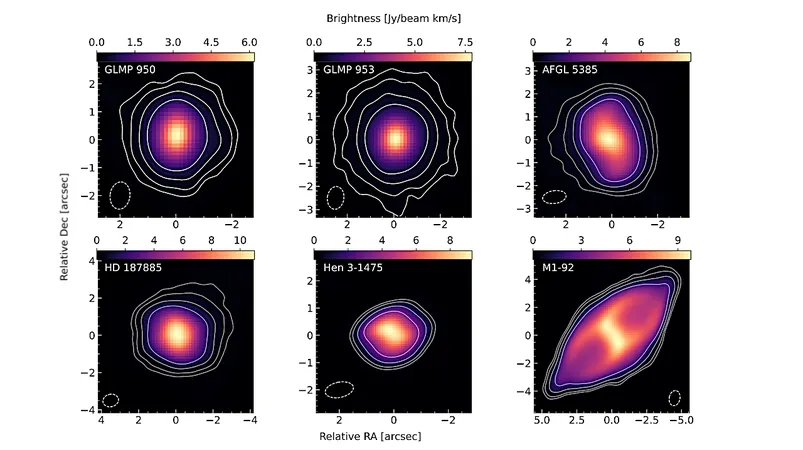
Shocking Discoveries: ALMA's Insights into the Mysterious Life of Obscured Post-AGB Stars!
2025-01-09
Author: John Tan
Introduction
Recent studies have unveiled significant revelations about the evolutionary paths of low- and intermediate-mass stars, particularly during the asymptotic giant branch (AGB) phase, when these celestial bodies tend to lose a vast portion of their initial mass. The surge in mass-loss rates observed towards the end of the AGB stage has puzzled astronomers, as it leads to the formation of post-AGB objects that are often heavily hidden within dense, dusty envelopes. This mysterious phenomenon is believed to be linked to interactions within binary star systems.
ALMA Observations
A groundbreaking observation made using the Atacama Large Millimeter/submillimeter Array (ALMA) has focused on the J=2-1 line of the carbon monoxide isotopologues 13CO, C17O, and C18O in six such obscured post-AGB stars. This research included a comprehensive sample of four carbon-rich and two oxygen-rich sources. The primary goal was to better understand the properties of their circumstellar envelopes, the chronology of recent mass-loss events, and the initial masses of the central stars.
Findings and Implications
One of the most striking outcomes of this study is the indication that all six stars possess relatively low initial masses, estimated to be below 2 solar masses. This contradicts previous literature, which suggested that some of these stars might have had a significantly higher mass. For instance, HD 187885 was determined to have a mass of approximately 1.15 solar masses, which is notably low for a carbon star.
Further analysis revealed high-velocity kinematic components in all but one of the observed sources (GLMP 950), with speeds exceeding 30 km/s—significantly greater than the typical outflow velocities associated with AGB winds. Many of these faster-moving outflows exhibited intriguing point-symmetric morphologies, with the star Hen 3-1475 standing out due to its spectacular high-velocity molecular outflow that intermingles with an equally rapid outflow of ionized gas, observable at optical wavelengths.
The research also provides insights into the age and mass-loss rates of these stars. By examining the dimensions of the emission regions linked to the slower components of the outflows, researchers estimated kinematic ages around 1,500 years and determined mass-loss rates to be approximately 3 x 10^-4 solar masses per year. Significantly, stars with known spectral types appear to have evolved at a pace outstripping the predictions made by current stellar evolutionary models.
Conclusion
This study paves the way for a deeper understanding of the life cycles of stars in our universe and raises intriguing questions about the dynamics at play during the latter stages of stellar evolution. The implications of the findings could reshape our comprehension of how stars like these transition into their final forms—an exciting prospect for future research in astrophysics!

 Brasil (PT)
Brasil (PT)
 Canada (EN)
Canada (EN)
 Chile (ES)
Chile (ES)
 Česko (CS)
Česko (CS)
 대한민국 (KO)
대한민국 (KO)
 España (ES)
España (ES)
 France (FR)
France (FR)
 Hong Kong (EN)
Hong Kong (EN)
 Italia (IT)
Italia (IT)
 日本 (JA)
日本 (JA)
 Magyarország (HU)
Magyarország (HU)
 Norge (NO)
Norge (NO)
 Polska (PL)
Polska (PL)
 Schweiz (DE)
Schweiz (DE)
 Singapore (EN)
Singapore (EN)
 Sverige (SV)
Sverige (SV)
 Suomi (FI)
Suomi (FI)
 Türkiye (TR)
Türkiye (TR)
 الإمارات العربية المتحدة (AR)
الإمارات العربية المتحدة (AR)